
Bay Laurel: planting, pruning and care
Contents
The bay laurel in a few words
- The bay laurel (Laurus nobilis) is a bush naturalised for millennia in the Mediterranean basin.
- Its aromatic and leathery leaves are used in bouquet garni to flavour sauces and stews. They also have medicinal properties.
- This ornamental bush with evergreen foliage produces creamy white to creamy yellow flowering in spring.
- The flowers yield shiny black berries that delight garden birds.
- The bay laurel can only withstand temperatures below -12°C for a short time.
- The bay laurel (Laurus nobilis) should not be confused with the oleander (Nerium oleander), the laurustinus (Viburnum tinus), the Portugal laurel (Prunus lusitanica), or the cherry laurel (Prunus laureacerasus), as they do not belong to the same genus. Moreover, the oleander is classified as a highly toxic plant.
The word from our expert
To reap laurels”… Naturally, this expression refers to achieving victories. But it is indeed the bay laurel (Laurus nobilis) that we are talking about. Indeed, this evergreen bush, with its glossy dark green leaves, is the symbol of victory among the Greeks and Romans. Were not the heads of the winners of the Pythian Games at Delphi crowned with a wreath of bay laurel leaves?
Beyond its symbolism, often associated with glory, success, and even immortality, the bay laurel is a bush from the Lauraceae family, highly prized by gardeners. It is, in fact, a bush of rare elegance, thanks to its glossy, undulate-edged foliage and its conical silhouette, which makes a striking impression along sunny façades or even as a hedge. When crushed, these leaves also release a very distinctive fragrance. This is why they flavour many dishes, especially since, when dried, they retain their aromatic properties. They can be harvested throughout the year, as needed. But this foliage also has medicinal and repellent properties.
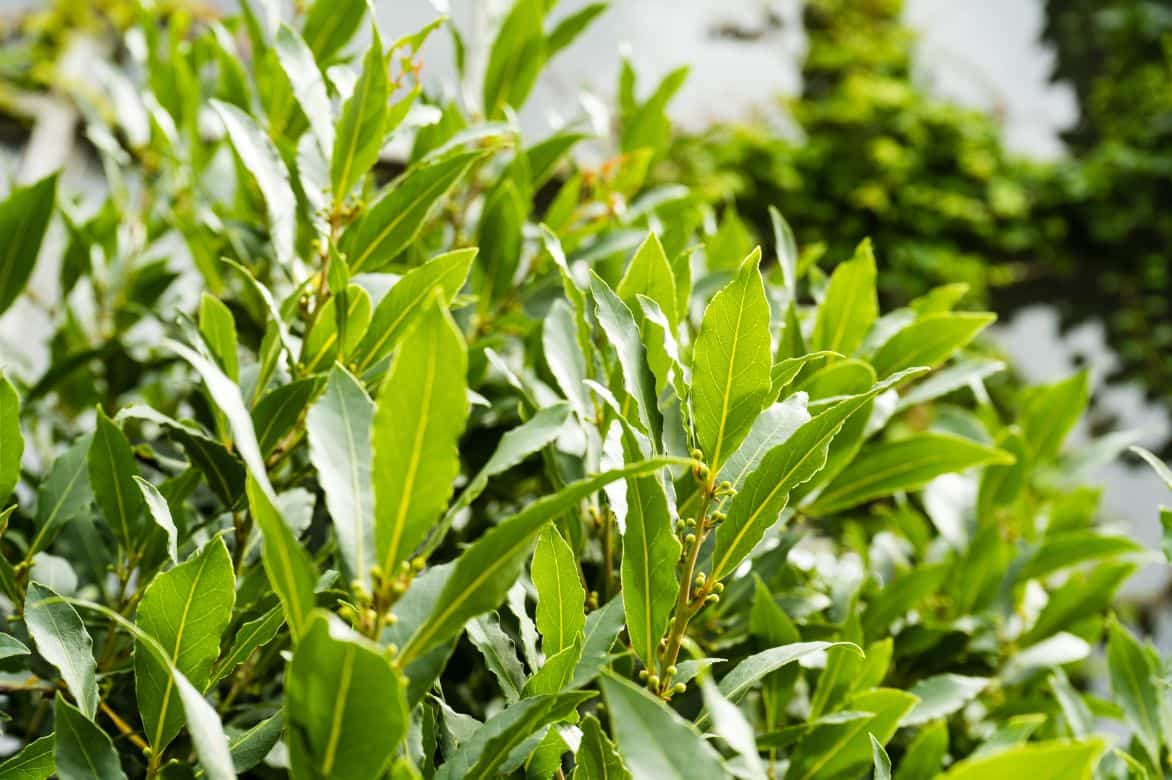
The bay laurel (Laurus nobilis)
In spring, the bay laurel displays creamy white to yellow flowers, clustered in axillary bouquets. On female plants (the bay laurel is a dioecious variety of bush), ovoid black drupes follow. These are a delight for garden birds in autumn and winter.
This very graceful bush is highly resistant to drought and sea spray. However, its hardiness officially does not exceed -12°C. That said, when well-established in a sheltered spot, it can withstand lower temperatures. Even if touched by frost, the bay laurel quickly regrows from the base. Very resistant to pruning, it is well-suited for creating windbreak hedges in Mediterranean or Atlantic coastal regions, or even for topiary art. It can even serve as an interesting alternative to boxwood.
Read also
How to Dry Bay Leaves?Botany
Botanical data
- Latin name Laurus nobilis
- Family Lauraceae
- Common name bay laurel, noble laurel, true laurel, Apollo's laurel
- Flowering from March to April-May
- Height 2 to 6 m
- Exposure Full sun, partial shade
- Soil type Well-drained, fertile, moist
- Hardiness Down to -12 to -16 °C
The genus Laurus comprises only two species in total: Laurus nobilis, our famous bay laurel, and Laurus azorica, a tree native to the Canary Islands and the Azores, with a slender, conical habit that can reach 20 m in height. Its leaves can also be used in cooking, but their aromatic power is significantly weaker.
First and foremost, it is essential to distinguish the bay laurel (Laurus nobilis), a member of the Lauraceae family, from the various bushes commonly referred to as laurels, as some are extremely toxic. Starting with the oleander (Nerium oleander), which boasts a magnificent display of white, pink, salmon, orange, or red flowers, but whose foliage is highly toxic, even deadly. The bay laurel also differs from the laurustinus (Viburnum tinus), a member of the Caprifoliaceae family, an evergreen bush with winter-flowering pinkish-white umbels. Its leaves, while non-toxic, are not edible. However, its berries are highly prized by birds. The Portuguese laurel (Prunus lusitanica) is an evergreen bush with spring-flowering white elongated clusters. Its leaves and berries are toxic to humans and pets. Finally, the cherry laurel or English laurel (Prunus laurocerasus) is a bushy shrub with large, narrow leaves. These last two laurels belong to the Rosaceae family.
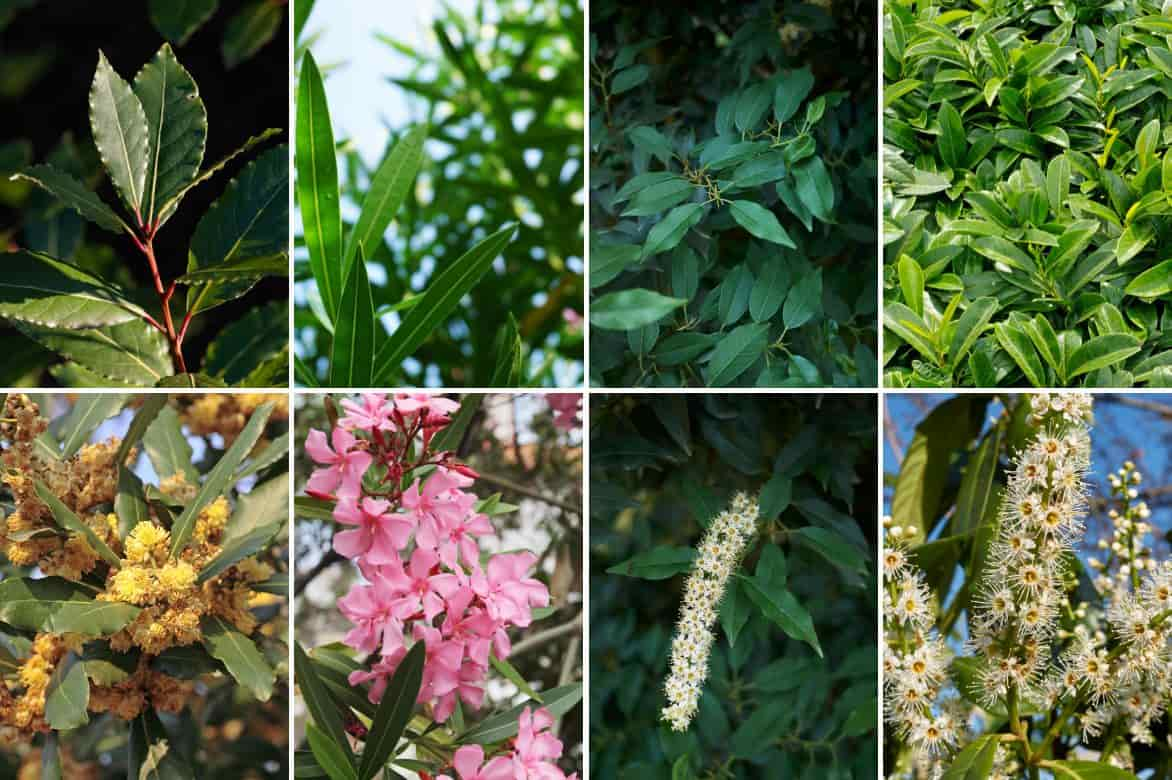
From left to right, leaves and flowers of bay laurel, oleander, Portuguese laurel, and cherry laurel
But let’s return to our bay laurel, also known by the vernacular names of noble laurel, true laurel, or Apollo’s laurel! The latter term allows us to delve into history. Indeed, arriving early from Asia Minor, the bay laurel has naturalised around the Mediterranean since antiquity. While the Greeks called it Daphne, this was in reference to the nymph of the same name, who, to escape Apollo’s advances, was transformed into a bush by her father, Peneus, the river god. Apollo adopted it as his tree, which became a symbol of triumph, as well as song and poetry.
Under the Roman Empire, the bay laurel crowned the heads of triumphant generals, victorious over their opponents. It became the allegory of victory, glory, and triumph, also awarded during sporting competitions. Later, in the Middle Ages and the Modern Era, the laurel wreath continued to symbolise victory. It also represents academic success! The term “baccalaureate” even derives from the Latin “bacca” (berry) and “laurus” (bay laurel).
The bay laurel belongs to the botanical family Lauraceae. Likely originating from Asia Minor, the bay laurel still grows wild in Turkey, Syria, Spain, Portugal, and Morocco… It is a bush or small tree tied to the Mediterranean basin, reaching 2 to 10 metres in height and 6 metres in spread. However, with regular pruning, its growth can easily be controlled.
With a conical silhouette and a dense, wide columnar habit, the bay laurel is characterised by its numerous upright, flexible green branches and grey bark. It is a dioecious genus, meaning male and female flowers appear on separate plants. Thus, only female plants bear drupes.
The evergreen leaves of the bay laurel, 5 to 10 cm long, are alternate, elliptical to lanceolate, penninerved, entire, and slightly undulate with smooth edges. Leathery, they display a dark, glossy green on the upper side and a duller green underneath. The veins are faintly marked with yellow, and the petioles are reddish. But this foliage is most remarkable for its aromatic power when crushed, which persists after drying.
Flowering occurs in spring, between March and April-May, depending on the region and climate. The flowers bloom on the year’s stems. The pedunculate, involucrate umbels, grouped in small axillary clusters of tiny unisexual flowers, range from creamy white to buttery yellow. They are delicately fragrant. Each flower has 8 to 12 stamens in two rows. The female flowers produce ellipsoid drupes, black in colour, containing a single seed. These berries are highly prized by garden birds, which disperse their seeds as they forage.
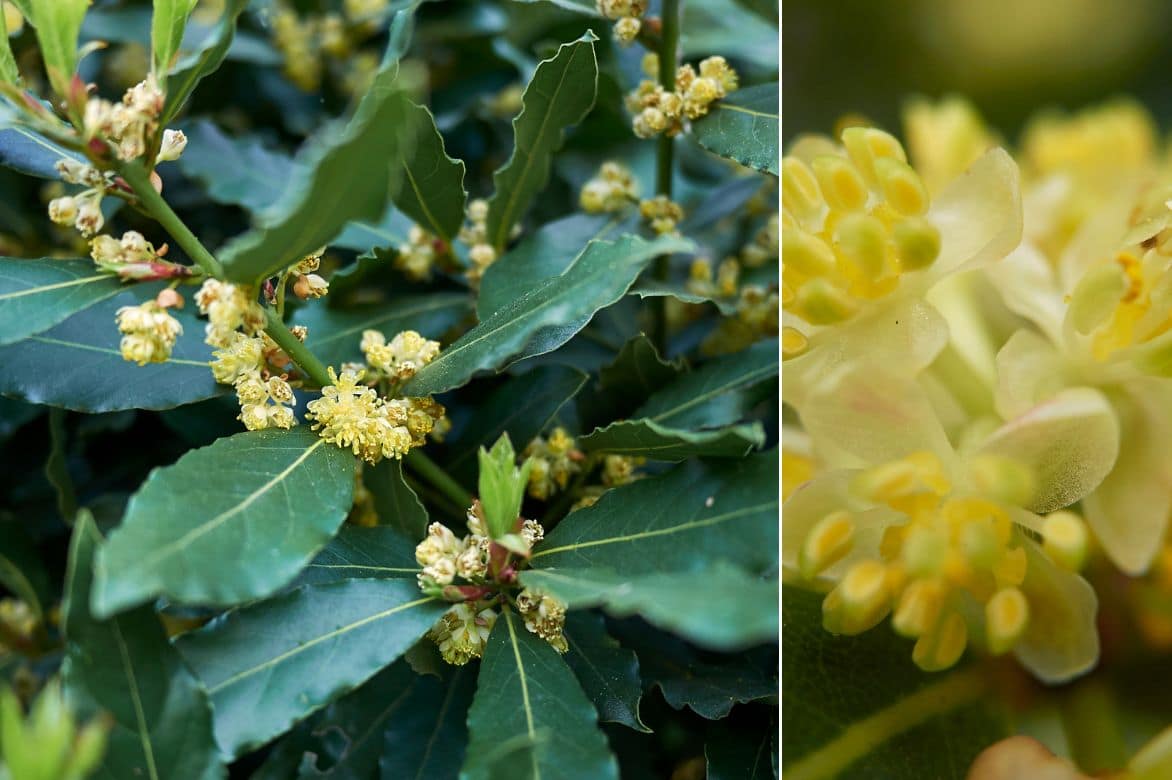
Bay laurel flowers
The leaves and flowers of the bay laurel contain essential oils, rich in aromatic and terpenic compounds, as well as alkaloids, particularly cineole and linalool. This is why the leaves have strong aromas, making them ideal for bouquet garni or flavouring sauces. They can also be infused. However, the wood of the bay laurel emits a strong, acrid odour when burned.
Naturalised in the Mediterranean basin, the bay laurel is resistant to drought and sea spray but has only moderate hardiness. It can withstand frosts of -12 °C to -16 °C but only for short periods. In regions with recurrent frosts, it will suffer and be severely affected. However, it can regrow from the base in spring. That said, the bay laurel has a rather slow growth rate.
The bay laurel adapts well to planting and cultivation in large pots on a balcony or terrace.
Our favourite varieties
The genus Laurus nobilis includes several varieties or cultivars. For instance, Laurus nobilis ‘Augustifolia’ has slightly narrower and paler evergreen leaves compared to the standard variety. ‘Aurea’ stands out with its golden-yellow foliage, while Laurus nobilis var. crispa features equally narrow but highly undulate leaves. As for Laurus nobilis ‘Undulata’, its foliage is deeply undulate and marginate with cream. A few cultivars have further enriched the range:
Our most interesting varieties:
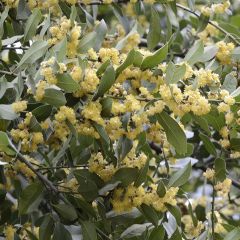
Laurus nobilis - Bay Laurel
- Flowering time April to June
- Height at maturity 6 m
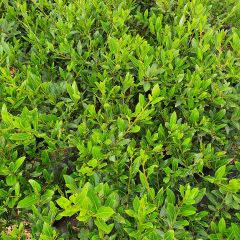
Laurus nobilis Little Laura - Bay Laurel
- Flowering time April, May
- Height at maturity 4 m
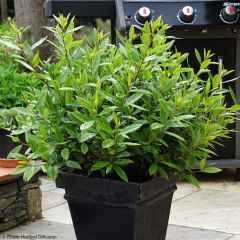
Laurus nobilis Little Ragu - Bay Laurel
- Flowering time April, May
- Height at maturity 2 m
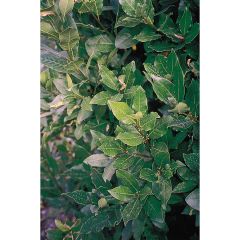
Laurus nobilis Jerusalem - Bay Laurel
- Flowering time April, May
- Height at maturity 3 m
Discover other Bay laurel
View all →Available in 4 sizes
Available in 1 sizes
Available in 1 sizes
Available in 2 sizes
When, how, and where to plant bay laurel?
Growing true bay laurel is not particularly difficult, provided you take care when planting it.
Where to Plant It?
Due to its Mediterranean origins, bay laurel prefers warm conditions. Therefore, it should be planted in full sun, in a spot well sheltered from cold northerly winds. Ideally, in regions north of Valencia, planting it against a south-facing wall is perfect, as it will be protected from frost.
In regions with very hot and scorching summers, planting it in partial shade is preferable.
In terms of soil, bay laurel also has a few small requirements. It thrives in loose, deep, light, dry, and well-drained soils, preferably fertile. However, it can tolerate a touch of lime or slightly sandy soil. Given its origins, it also copes well with dry soils.
Ideally, enriching the soil with compost and preparing it in advance will make it very happy.
In pots, bay laurel should be planted in a sufficiently large and wide container, at least 50 cm in diameter, with drainage holes and a layer of clay or gravel at the bottom. The substrate should consist of a mix of garden soil, compost, and sand. Terracotta pots are preferable, as they are more breathable.
When to Plant It?
Bay laurel can be planted either in spring, after the last night frosts, or in autumn, before the onset of severe cold and winter frosts.
How to Plant It?
- Soak the root ball in a basin of water
- Dig a hole twice the size of the root ball
- Loosen the bottom of the hole and add some well-rotted compost or dehydrated manure to the excavated soil. If the soil is heavy, adding sand is also advisable
- Place the bay laurel’s root ball in the centre of the hole and fill it with the excavated soil
- Firm the soil carefully to avoid air pockets and water thoroughly.
To learn more: How to grow bay laurel in the garden? Tips for planting and caring for bay laurel in pots or in the ground.
How to pair Laurus nobilis?
The bay laurel is relatively versatile since it will make an impact just as well as a standalone feature in the middle of a short grass meadow as it will at the back of a flower bed. Its dark green, glossy foliage will stand out among hardy geraniums and sneezeweeds, foxgloves, ground-cover roses, and purpletop vervains (Verbena bonariensis)… It will also find its place in a herb garden or an aromatic garden, surrounded by thymes, rosemary, and myrtles…
The bay laurel is also perfectly suited for hedges, particularly in regions with a mild climate, paired with photinias, viburnums, or oleasters (Elaeagnus).
It tolerates regular and repeated pruning very well. This is why it is an ideal subject for topiary enthusiasts, as an alternative to boxwood. It is also very easy to train a bay laurel into a standard, whether in the ground or in a pot. Virginie explains how to train a bay laurel into a standard.
The care of the bay laurel
To ensure the optimal growth and development of the bay laurel, a few maintenance steps are necessary. However, it is a robust, vigorous bush that is undemanding. It can even withstand periods of intense heat and drought without much trouble. It is also unaffected by sea spray.
Routine Care for the Bay Laurel
Despite its tolerance for heat and drought, some watering is necessary in summer, at least for the first two years after planting. After that, it can manage on its own. To reduce the frequency of watering and keep the soil slightly cool, mulching is recommended, ideally with dried grass clippings. Planting small flowering perennials at its base adds an aesthetic touch while helping it cope with drought.
On the other hand, if the bay laurel is grown in a container, watering will need to be more regular. Ensure that water never stagnates in the saucer or decorative pot.
In regions with harsh winters, a good mulch at the base will help the bay laurel withstand frost. Adding a winter protection cover is also recommended. The tips of the branches may sometimes freeze, but they can simply be pruned back to encourage new shoots in spring. The bay laurel’s worst enemy in winter is stagnant moisture, which is why it should be planted in perfectly drained soil.
Pruning the Bay Laurel
With a bushy habit that can sometimes appear irregular, this bush requires regular pruning for aesthetic reasons. Similarly, pruning helps control the growth of this vigorous bush. Additionally, it naturally has a conical shape, making it easy to prune into cones, columns, pyramids, or balls—much like boxwood. It can also be shaped into intricate animal or geometric forms.
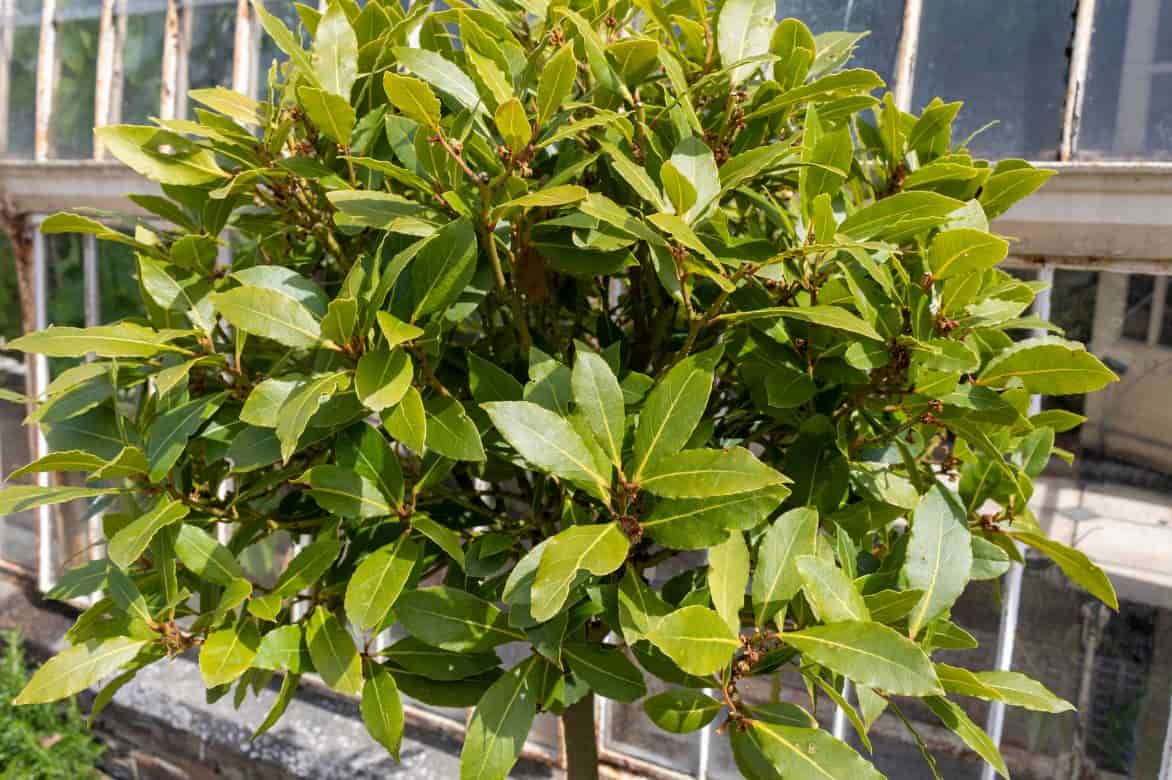
Bay laurel on a stem pruned into a ball
Pruning is done twice a year: in late spring, around April or May, ideally after flowering (which, being melliferous, attracts many pollinating insects) and in late summer to early autumn, between August and October. Depending on the size of the bay laurel, pruning can be done with pruning shears or a hedge trimmer. In spring, pruning involves removing damaged, dry, or dead branches, as well as balancing the branches or shaping the bush as desired. In autumn, the young shoots of the year are shortened.
Diseases and Pests of the Bay Laurel
Bay laurel is fairly resistant to the most common fungal diseases. Only sooty mould can affect it, but this usually results from an attack by aphids or scale insects, two parasitic pests to which bay laurel is susceptible.
However, the most widespread and damaging pest remains the bay sucker (Triosa alacris). These insects, quite similar to aphids, are sap-suckers. They puncture the foliage, which becomes covered in scabs, curls up, blisters, and deforms. The leaves eventually dry out. The bay suckers also hinder the proper development of young shoots.
To learn more about bay suckers: How to get rid of bay suckers? Prevention, control, and natural treatments
The propagation of Laurus nobilis
Bay laurel can be propagated by sowing, by semi-hardwood cutting propagation, or by layering.
Sowing
Bay laurel produces black drupes containing a seed that will be stripped naked and washed. The bay laurel seeds must then be stratified for at least 1 month, ideally 3 to 4 months in the refrigerator. They should be sown at a depth of 0.5 cm in trays filled with turf or sowing compost, mixed with sand. The trays should be placed in a bright room with a temperature of 20°C. Regular watering with a fine spray is necessary.
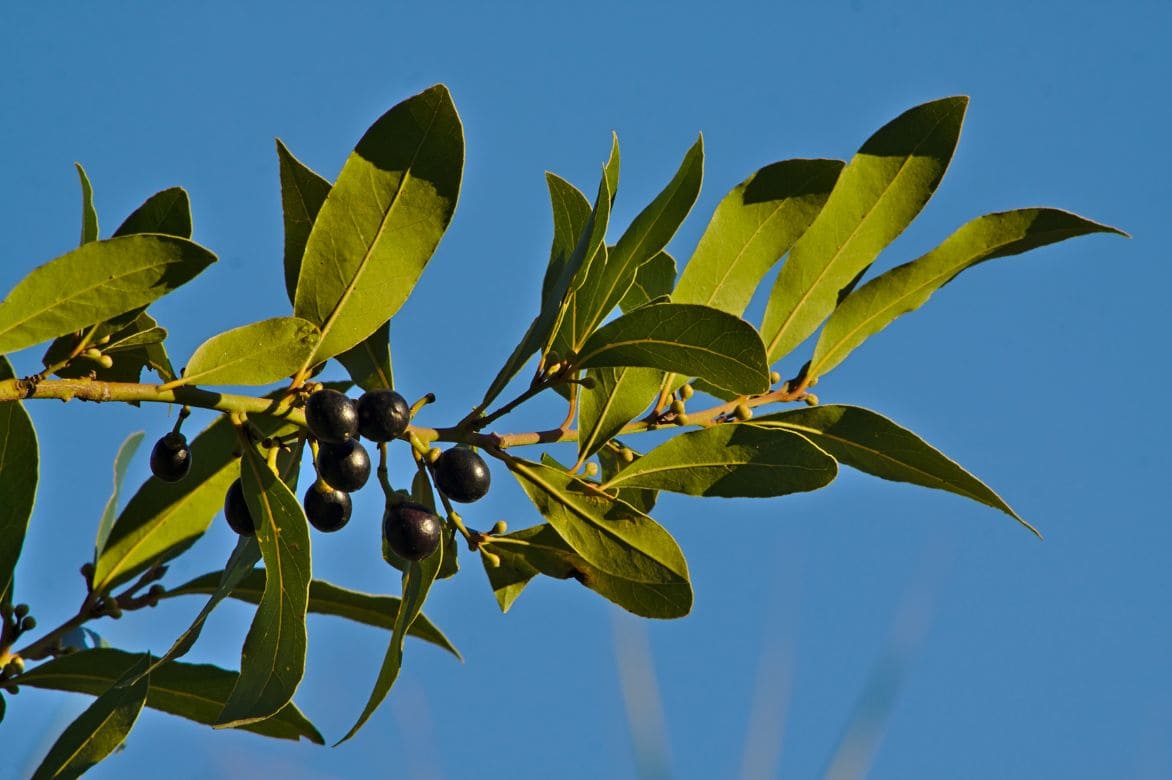
Bay laurel drupes
Germination occurs within 30 to 40 days. The young plants can then be transplanted into buckets and planted outdoors in spring.
Propagation by cuttings
Bay laurel stem cuttings are best taken in July or August. Simply take 15 cm long semi-hardwood stems from the current year and remove the lower leaves. The stems are then inserted into a mixture of sowing compost and sand and kept at 20°C. After two to three months, the stems are transplanted into buckets and placed in a room with a temperature of 10 to 15°C throughout the winter. The cuttings are planted outdoors in spring.
Layering
In spring, select a sucker about 50 cm from the base of the bay laurel. Remove the leaves and lightly score the stem where it will be buried (the soil should have been prepared beforehand). Then, simply bury the stem and secure it with a ring.
Once it has taken root, all that remains is to separate the cutting from the parent plant using a spade.
The harvest and consumption of the leaves
Bay leaves can be harvested as needed, preferably outside the flowering period. Allow for two to three fresh leaves per dish, adding them to the broth or sauce at the start of cooking. However, these leaves are not meant to be eaten and should be removed before serving.
You can also incorporate dried leaves into your culinary preparations, which are just as aromatic. To dry bay leaves, pick a branch and hang it upside down in a well-ventilated, frost-free, and dark room. The dried leaves can be stored in an airtight jar for several months, alongside thyme and rosemary to create the famous bouquet garni. 
Dried leaves can also be infused. Use 4 dried leaves for 250 ml of boiled water and let them steep for 10 minutes. This infusion has expectorant and antiseptic properties for sore throats or flu. It is also beneficial for digestion and stress relief.
Finally, bay laurel is one of the effective natural moth repellents: discover how to use it for this purpose.
- Subscribe!
- Contents




































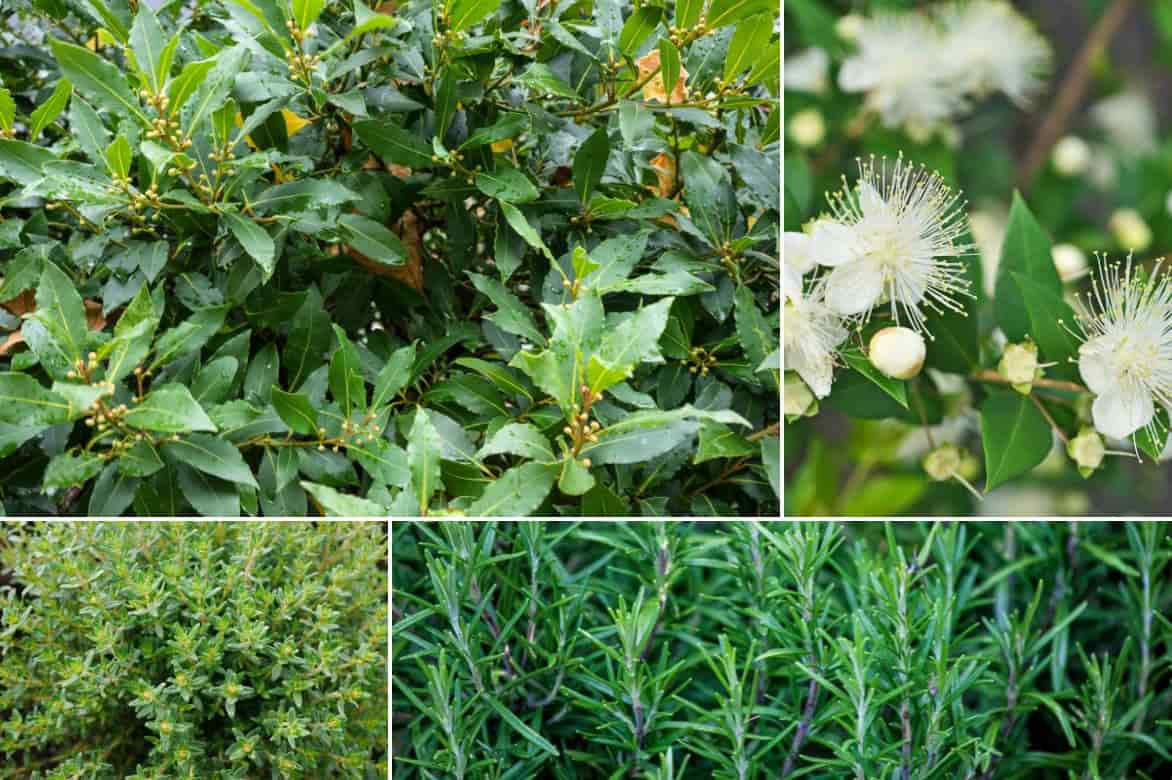
Comments